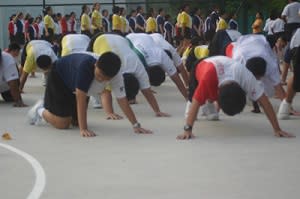“Obesity” has become a dirty word, which is linked to a whole host of health problems, including diabetes, high blood pressure, and hypertension – these days, they’re associated with higher risk of complications from Covid-19. But the war on obesity isn’t new – the Singapore government tried to tackle the issue with school children back in the 90s.
If you know anyone who attended local school in the 90s, you may have heard of school-run fat camps that shamed kids into losing weight. The programme’s name was “Trim and Fit” – aka TAF Club, or for the cynics, FAT spelled backwards.
TAF programme
In 1992, Singapore’s health ministry launched TAF to promote a healthy lifestyle to address obesity, and it was an annual health screening exercise where children aged 9-18 were assessed by a doctor. If a child failed to meet “healthy” guidelines – if they have a BMI that was considered obese (in Singapore it’s 27.5 and above) – they’d be put in the TAF club whether they liked it or not. Even their parents were told what they needed to do to control their child’s weight.
That’s right: the school measures a child’s BMI and separates anyone overweight into a mandatory fat camp. On paper, it sounds like a targeted programme aimed at getting these children fit and healthy, but in reality, the programme stigmatised the overweight and fat-shamed all those in the TAF Club.

Fat-shaming methods
Instead of spending time with their friends, TAF kids were called out (in front of assembly and in classrooms) and told what to eat, and were placed on a strict exercise routine, with their progress re-evaluated every 6 months. Students deemed overweight were subjected to additional intense exercises for at least 1.5 hours per week, and the programme came at a psychological cost of participants being stigmatised.
Recess is fat-shaming time: Ask any TAF kid, and they’ll tell you that recess time isn’t a happy time because when the bell rings, it’s time for exercise. Most TAF kids skipped the 30-minute recess because it was replaced with exercise; some ran 2.4km on the school track, some did jumping jacks right in front of the school canteen where other “healthy” schoolmates ate. In one case, the teacher in charge of the exercise would yell at the kids for being “lazy and fat.”
Being called out in morning assembly: In some schools, the teachers in charge of TAF would call out students in front of the assembly for being too lazy to exercise. Sometimes, schools would make a public announcement for all TAF club members to stand up.
TAF kids started school early/ended late: Many schools implementing TAF made their members exercise early in the morning before assembly. Some would go for runs or exercise around the field for 20 minutes – this meant that they would sit with latecomers instead of classmates during assembly. Some were separated to do different exercises during physical education classes or even made to stay in school after teaching hours to increase their physical activity.
TAF kids were sweaty: When you have to exercise before assembly and/or during recess without the opportunity to shower, chances are you’ll be known as the stinky kid in class because you’d be sweaty.
You can leave TAF but… even when you’ve left school and lost weight, you’ll forever be remembered by the teacher as “that TAF kid.”
The psychological price
Since the implementation of TAF, the prevalence of obesity declined from 16.6% to 14.6% between 1992 and 2000 among primary 6 students (11-12 year olds), and from 15.5% to 13.1% among secondary 4 students (15-16 year olds).
But at what cost? In 2005, a National University of Singapore study of schoolgirls linked TAF to an increase in eating disorders. But the programme wasn’t just harmful for girls.

“Was in TAF club, and it didn’t help at all with me losing weight, in fact it gave me an eating disorder that I still struggle with 8 years later. I didn’t learn how to exercise healthily or understand the basics of a healthy diet to properly lose weight, all it taught me was that unless my weight went below a certain number, I was worthless,” says Redditor melonmilkfordays.
For some former members of the TAF Club, it seemed to serve no lasting positive outcome except for the stigma placed on being overweight. “The TAF Club concept is good but the way they deliver it to us is wrong. Because of the stigma involved, and the lack of interesting activities, none of us was really motivated to lose weight,” said a male Catholic Junior College student whose weight stayed stubbornly at 75kg for the 2 years he was in the programme in the early 2000s.
For Redditor PartTimeBomoh, “I don’t think they really taught me anything useful at all except to be fat shamed.”
Too much emphasis on numbers on a scale may be detrimental, as it sets people up for failure and increases their risk of shame. A Harvard Public Health article, “The Scarlet F” found that “weight stigma may be as harmful to the body in itself as poor diet and physical inactivity.”
The negative impacts of weight stigma is as rampant and as powerful as racial stigmatisation, and women who experience this type of weight prejudice may also be at a higher risk of bullying, depression, eating disorders, and other harmful addictions. Research shows that weight stigma can make it more difficult for overweight people to lose weight and keep it off, and in the process also impair their prospects in education, careers, romantic relationships, and physical activity.
Given the negative reactions to the TAF programme, it was replaced with a Holistic Health Framework (HHF) in 2007 which encompasses a student’s physical, mental, and social health. While it’s beneficial to overweight students, it’s open to all who want to participate, thus reducing the stigma of being obese and losing weight.











